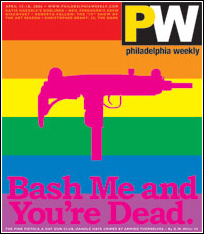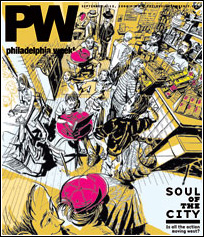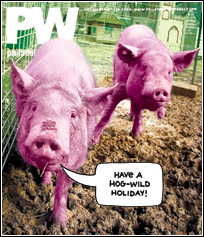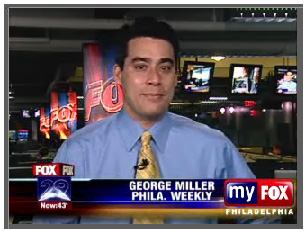Walking it Off
Just weeks before their annual Interfaith Peace Walk, a South Kensington mosque weathers one member's connection to the planned terror attack at Fort Dix.
From the May 30, 2007 Philadelphia Weekly
When the noon prayer period ends at the Al-Aqsa Islamic Society, the area erupts with life.
Children laugh and yell and play basketball adjacent to the main building. Women dressed in blue, black, maroon and olive-colored hijabs - full Muslim dress - kiss each other on the cheek - right, left, right, left - as their designer handbags dangle from their wrists.
Grinning men honk their car horns and bellow Arabic greetings to friends as they drive past the pristine painted and mosaic facade of the landmark South Kensington structure.
The random car blaring salsa music or hip-hop rolls past without stopping, even at the stop signs. Most people, it seems, barely notice the tiny exotic enclave just blocks away from hipster hangouts in Fishtown and Northern Liberties.
The only time most Philadelphians hear about Al-Aqsa is when something negative involving Muslims happens. The media descended here after the 9/11 attacks. They returned when the war began in Iraq.
"The problem is when we do get attention, we're defending ourselves," says Adab Ibrahim, a committee member at the Society.
Al-Aqsa was in the news most recently as the place of worship for Mohamad Schnewer, one of the six men charged with planning the thwarted attack on Fort Dix. Three other suspects - the Duka brothers - had been repairing the roof on the converted warehouse that now serves as a school, mosque and community center.
Those connections have nothing to do with the mission of Al-Aqsa, members say. They aren't harboring terrorist cells or promoting radical ideas.
"There's a fear of Arabs and Muslims," says Marwan Kreidie, executive director of the Arab American Community Development Corporation, which is housed at Al-Aqsa. "But the closer you are to our community, the less you fear us."
Which is one of the reasons why the Interfaith Walk for Peace and Reconciliation came into existence.
***
Vic Compher organized the first Peace Walk in 2004 as an event where Muslims, Jews and Christians could walk, talk, pray and break down misconceptions.
"Historically there has been quite a gulf among the various religions," says Compher, who worships at University City's Tabernacle United Church. "The 9/11 tragedy served as an impetus for us to really get to know each other."
The goal of the Peace Walk is to erode the erroneous religious stereotypes that are formed through ignorance.
"The walk itself is a walking dialogue," Compher says. "The emphasis has been to develop relationships of friendship and mutual respect."
At the first event more than 400 people of various faiths prayed at Al-Aqsa before marching to St. Augustine's Church in Old City. Then they walked to Independence Mall and City Hall, and prayed at Congregation Rodeph Shalom on North Broad Street.
"I see the violence that's going on in the world, the religious strife, and I like to think there's a different way," says Lance Laver, a congregant at Manayunk's Mishkan Shalom and one of the original Peace Walk organizers. "We try to reinforce the fact that we don't have to fight with each other."
The fourth annual walk will start at 1 p.m. Sunday at Masjid Muhammad on East Penn Street near Belfield in Germantown. They'll walk to St. Vincent's Church on East Price Street, then to the Germantown Mennonite Church on Washington Lane. The walk will conclude with services at the Germantown Jewish Centre in Mt. Airy around 4 p.m.
As the event has evolved over the years, the focus has changed from predominantly Muslims, Jews and Christians to people from all faiths including Buddhists, Hindus and Sikhs. This year, in recognition of the city's wave of deadly crime, part of the walk will be held in silence.
"A lot of people feel this is the only way we can deal with the violence here and overseas," says Ibrahim, who coordinates Peace Walk efforts at Al-Aqsa.
All those attending the walk are asked to wear white. No signs or banners are allowed unless they involve messages of peace.
"It's not a political march," Compher says. "It's more a spiritual practice that involves prayers at all the different locations."
***
"There was so much despair in the aftermath of 9/11," says Renate Woessner, a Peace Walk planner. "There was so much dread, and we felt like we couldn't do anything. The Peace Walk became the antidote."
But the cultural and religious exchanges don't stop with the once-a-year event. Bi-weekly interfaith meetings are held at Al-Aqsa with meditation, prayer and religious discussion. They also organize multidenominational events like volunteer days at Philabundance and neighborhood cleanups.
"The work itself is sort of a vehicle for us to get to know each other," Compher says.
It was a collaboration of community organizations and local schools that cleaned the neighborhood around the Islamic Society in 2004 and created the elaborate murals that wrap around the building. They painted three colorful portals on the building with the words "love," "peace" and "hope" written in 25 different languages.
"Just a few years ago this was a run-down, crack-infested area," says Ibrahim, whose father immigrated to the old industrial neighborhood from Palestine in the late 1960s. She still lives just a few blocks away. "Now it's beautiful."
Sometimes interfaith delegations visit other congregations for religious seminars. An Islamic scholar recently taught a workshop on the Koran at Mishkan Shalom, infusing the discussion with connections between the Muslim holy text and the Christian and Hebrew bibles.
"That was really a lesson for me," says Laver. "Through the Peace Walk I've expanded my understanding of other traditions."








